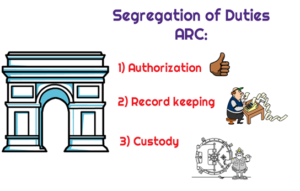- “Learn everyday, especially from the experiences of others. It is cheaper’… Jim Bogle
Dear Reader, I hope my last article refreshed your memory of some basic banking concepts which can never be replaced or done away with. The fraud case involving the American banking officer happened in a traditional banking set-up. Although most banking transactions have been replaced with digital ones, the segregation of duty (SoD) principle is always embedded in all transactions.
Why is it important to have segregation of duties especially in transactions involving money?
By separating duties, it is much more difficult to commit fraud, since at least two people must work together to do so – which is far less likely than if one person is responsible for all aspects of an accounting transaction.


Standardization of Branch Procedures
Whatever the size of your financial institution, from the smallest microfinance company, to the savings and loans company, or even the biggest universal bank, the SoD principle is still a necessary evil that should be adopted, and not done away with, even during cost reduction programs.
As a manager branch expansion, therefore, becomes a real test of the structures of the systems in place. If there is a loss of control and the systems vary among the branch network, it becomes an avenue for disaster. Virtual monitoring of the systems is key to risk management.
Even if your eyes are not everywhere, the risk triggers should track down any lapses in the system, for easy correction. The absence of control in some outstation branches of some banks breeds indiscipline and lapses for misappropriation of assets. The success of branch expansion programs depends closely on the success of the head office systems.
The Colorado Bank Teller Fraud case (Within Traditional Banking Set-up)
Let us look back at the publication of the case of the Operations Officer of the Bank of Colorado, USA and examine the causes of the massive fraud by this “trusted” worker. I wonder what the bank thought about her prior to the detection of the fraud. Obviously, she would have been a star worker and a darling of the bank; playing the part of the utility player in the branch, doing everything from A to Z with very little supervision. Once again, I quote William Shakespeare: “There is no art to find the mind’s construction in the face”.
Fraud is no “respecter” of persons. Anybody can, and has the ability to commit fraud. The lady in question had been promoted from the head book-keeper to the operations officer. Did you also notice the length of time it took for the fraud to be detected? Four solid years!
Let us examine some of the red flags in the case, which illustrates a good example of the lack of segregation of duty in the branch concerned, leading to a loss of $565,000. We shall take some extracts from the case and question the structures in place:
FACT:
- She performed unauthorized electronic transfers by means of block entries from customers’ accounts into her own accounts as well as accounts of family members and other customers.
QUESTION:
What measures were there in the branch to cross check transactions being executed? Whom did she report to? Was she too “big” to be checked? In these days of “voucher-less” transactions, how are electronic transactions effected and checked? Are there any electronic built-in systems to ensure block entries are checked before being posted into the accounts and its effect on the general ledger.
How do these appear on the general ledger in the system? Were there no reports to check when an official conducts transactions on his/her account? Is it even allowed? Were there no triggers in the system?
FACT:
- The woman avoided detection by developing elaborate means of re-crediting those accounts before the end of their statement cycles, Concealing the unauthorised transfers, and creating and distributing false monthly statements.
QUESTION:
The same questions apply here too. What elaborate means can one create to re-credit accounts? Who is checking who? Are there no snap checks by Internal Control staff? Were there no suspicious transactions seen during the four years?
What is the process of printing and distributing statement like? Who has the rights to print statements? Is there no segregation? How can one person print and distribute? Of course, statements can be suppressed or diverted by internal fraudsters.
Does your bank receive occasional complaints from customers about non-receipt of statements? If your company uses e-statements, what controls are there to prevent manipulation and suppression of these e-statements?
Do the personnel who receive cash and cheques (Marketing and Sales staff, Tellers, etc) also have system rights to print and send statements? Who controls the statement printing and the dispatch process? Even in these days of e-statements, there should still the “Maker-Checker” effect. Emails of customers should be accurate to avoid mis-direction, causing reputational damage when the bank is sued for breach of confidentiality!
FACT:
- She was in charge of customer inquiries, and bank employees were instructed to direct complaints to her.
QUESTION:
Is there a central pool for complaint management in your bank? Who is in charge? Is it automated and logged for monitoring purposes and for the avoidance of suppression of customer complaints? What are the benchmarks for complaint handling and resolution? Is there a segregation of roles to ensure that complaint resolution is dually owned by both the front and back offices?
Is it monitored centrally from the Service Quality/Assurance department? Does the complaint management system not generate reports indicating the trends in complaints investigated to know the sources and hot spots? Are there departments/branches registering many complaints? If yes, ask the Internal Control to check up on them and run snap checks. For all you know it could be a leadership problem in the branch leading to cracks in discipline and a target for fraudsters (both internal and external)
Next week, I shall continue to explain more aspects of the segregation on banking, for a better understanding of the reasons behind certain rules and regulations in transactional banking. Stay tuned.
For more insights on this topic, please book a copy of my new book, “THE MODERN BRANCH MANAGER’S COMPANION” which involves the adoption of a multi-disciplinary approach in the practice of today’s branch management. It also shares invaluable insights on the mindset needed to navigate and make a difference in the changing dynamics of the banking industry. Call 0244333051 for your doorstep delivery.
TO BE CONTINUED
ABOUT THE AUTHOR
Alberta Quarcoopome is a Fellow of the Institute of Bankers, and CEO of ALKAN Business Consult Ltd. She is the Author of Three books: “The 21st Century Bank Teller: A Strategic Partner” and “My Front Desk Experience: A Young Banker’s Story” and “The Modern Branch Manager’s Companion”. She uses her experience and practical case studies, training young bankers in operational risk management, sales, customer service, banking operations and fraud.
CONTACT
Website www.alkanbiz.com
Email:alberta@alkanbiz.com or [email protected]
Tel: +233-0244333051/+233-0244611343










